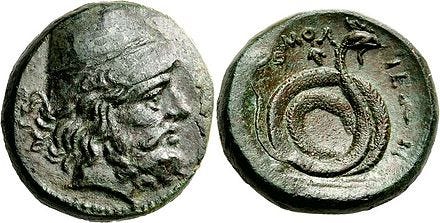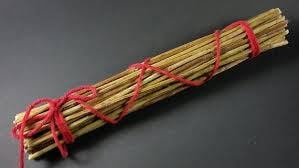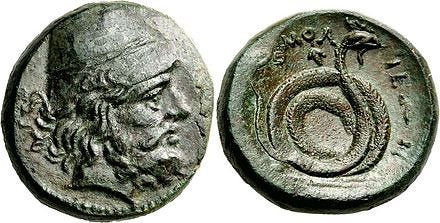This piece from circa 2015 was originally published in Volume 1 of the now-defunct journal Numen Naturae. I’ve decided to re-publish it here in two parts with some light edits . -JEd
Unsure where to begin, I reach for the Yarrow stalks, bundled in their blood-red cloth and untouched for too long now. Lighting a candle, I set the mind’s flurry of concerns off to the side and focus on the task at hand: articulating the gifts of Yarrow, master plant teacher and linchpin of the Chinese oracle and book of wisdom, the Yijing.
Here I can’t help but pause for a moment and smile. Plant teacher? Ancient oracle? All this would have sounded highly questionable not so many years ago, before a growing curiosity in matters mystical sent me headlong down the rabbit hole on a fool’s quest for gnosis. Teacher plants and the Yijing (also spelled I Ching) played key roles in the ensuing journey, a passage that was to turn my mind inside out and stretch my sanity to its limits…
With a half-rueful shake of the head I return to the present and unwrap the fifty Yarrow stalks. Setting a single stalk along the top edge of the rectangular cloth, I begin dividing, counting, and re-dividing the rest. In fact, I have trouble recalling exactly what to do, for I’ve fallen into the habit of resorting to more expedient means of consulting the Yijing: coins, or even, on occasion (cringe) a phone app.
Performed with the stalks, Yijing divination is laborious enough to forestall silly questions, time-consuming enough to help one settle into a receptive state. Seduced by the bustle of city life, I seem to have forgotten these things, and am duly chastened. It’s back to basics today, then—back to the root.
I take up the stalks once again and manipulate them with my query in mind—a simple plea for guidance in the writing of this piece. One by one the yin (broken) and yang (whole) lines emerge to form a “hexagram”: in this case Hexagram 62, Xiao Guo. This symbol has two yang lines sandwiched between two yin lines above and another two yin below, giving Xiao Guo a squeezed look like a board in a carpenter’s vise.
Neither this visual nor the juxtaposition of the symbol’s constituent trigrams—Mountain below Thunder—is yielding me much at the moment, however. I turn to Liu Ming’s careful translation to reference the relevant bit of text. Paraphrasing Liu, Hexagram 62’s main text might be rendered:
The small succeeds, not major expeditions. Down, not up.
Therein lies an answer, but an answer to what? Are these gnomic phrases somehow key to Yarrow and the Yi itself, or did they appear as advice for me as I set about writing?
Experience suggests that the answer may well be ‘both’—and more besides.
I pause to consider. ’Less is more’, the oracle seems to be saying. (I make a mental note to pare down these many words). ‘Start small. Pay attention to details.’ And perhaps: ‘don’t get too big for your britches’—this last being sound advice for one whose insights sometimes outstrip his ability to act on them.
I linger a moment longer with the hexagram text. One phrase in particular stands out: down, not up. I look down and am greeted by the sight of my own two feet—and a plant, feather-leafed and unassuming, growing beside them.
The Wounded Heel
Yarrow or Achillea millefolium is named after the legendary Achilles, best-remembered today for his vulnerable heel and its namesake tendon. According to legend, Achilles learned the use of Yarrow as a vulnerary herb from the centaur Chiron, his mentor in martial and healing arts. Ever since, “soldier’s woundwort” or herba militaris has been valued on the battlefield to staunch the flow of blood from severe wounds.
Yarrow’s medicine runs deep as the blood itself; to run with it, we must follow the blood-line back to the mythological body, and enter it through the portal of a wound: a wounded heel, to be exact.
Down, not up: let’s begin at the bottom, at the foot. What is it about feet that makes them vulnerable? As storyteller Michael Meadeexplains, one of them is well-adapted, the ‘best foot’ we ‘put forward’ to climb the ladder of success. The other foot is, well, a bit weird:
“and weird means to have one foot in the otherworld…this malingering foot carries our limp and holds us back, but it also remembers essential things that we keep forgetting and leaving behind when we rush ahead…We may put our most adapted foot forward when practicality is called for; but when it comes to our actual calling in life, it is our mythic, awkward, and dream-bound limb that knows the way we must go. Because it causes us to limp and long for unseen things, it usually becomes covered up. We disguise our weirdness in order to seem like others or to get ahead in life. Yet the weird within us has its own ways of slowing us down and even stopping us cold. if we ignore this symptom-bearing limb too long it can cause an accident or an illness that stops us in our tracks. In the end, we can only go as far forward as we can reach back. And the weird within us would have us reach all the way back to the dream we brought to life and all the way down to where our deepest wounds seek to be healed” (Meade, Fate and Destiny, 170-1).
The limping foot results not from an incidental injury but from a fateful wound: a painful opening to transformation. Such wounds are part and parcel of the process of initiation, i.e. events that
“mark a man or a woman’s life forever, that pull a person deeper into life than they would normally choose to go. Initiatory events are those that define who a person is, or cause some power to erupt from them, or strip everything from them until all that is left is their essential self…there is a departure from daily life, a suffering of ordeals and dramatic episodes, and a return as a marked and different person” (Meade, Men and the Water of Life, 11-12).
Initiations come in many kinds. Of interest here are the ones that release the healer archetype that has lain dormant in the psyche. The full-blown initiation of a healer classically entails a brush with death and a subsequent rebirth. Often the trigger is an actual near-death experience, or else an ego-death such as those mediated by entheogenic substances in the shamanic cultures of the Amazon. Meade’s words, together with the myths he draws on, have helped me to understand my own initiatory passage, a roughly year-long period of teaching and testing, punctuated by ritual and retreat.
The details of that passage belong to another story. But taken as a whole, the period marked for me both the threshold of adulthood proper and the beginning of embodying my chosen role as healer. In the midst of the often-exciting, sometimes-terrifying sea change, it came as a real relief to find that a warm, wise elder understood what I was going through better than I did myself. Yet recognizing the nature of the transition is consoling only up to a point; the treacherous waters of psychic upheaval still have to be navigated. These are the waters in which the mystic swims and the madman drowns, as the saying goes. From them I came crawling and sputtering, battered but breathing. I had been shaken to my foundations, and once the dust settled I found myself possessed of a dramatically re-oriented perspective.
But here Meade had foreseen the challenge to come, for initiation is only a beginning: “the radical changes that initiation precipitates take a long time” to integrate. I sometimes wonder if a lifetime is sufficient for the job.
At any rate there was a more pressing problem: my initiation had entailed an opening to what might be called the spirit world or archetypal realm, but this psychic rift was not so easy to close up again. It amounted to a subtle but deep and troublesome wound.
It wasn’t until I encountered the myth of Philoctetes, however, that I realized the nature of that wound.
Snakebites and Poisoned Wounds
A contemporary of Achilles, Philoctetes was the wielder Hercules’ mighty bow and poison arrows, a gift the living legend bestowed upon Philoctetes from atop his funeral pyre—for Philoctetes alone consented to light the pyre of Hercules, writhing in pain and seeking an end.
Anyway, armed with this storied bow, Philoctetes sets off with Odysseus and company to besiege Troy. It’s the great war of their generation and a golden opportunity for ambitious young heroes make their name and fortune.
En route the Greeks stop at a temple to seek the blessing of Athena, goddess of war and patron of heroes. There, however, Philoctetes is bitten—on the foot, naturally—by a snake. Though he survives the initial bite, Philoctetes’ wound festers. The stench becomes so awful and the young warrior’s moans so piteous that no one can bear to be near him—a state of affairs that may resonate for many a socially marginal artist or healer.
When the situation persists, the Greek leader Agamemnon commands that Philoctetes be abandoned on Lemnos, a deserted island.
Accounts differ on what happens to Philoctetes on the island. In one version of the story he dies there, while in Sophocles’ play Philoctetes survives telling the protagonist but is unable to heal himself; eventually he is cured by a son of the divine physician Asclepius. The presence of the snake suggests a third alternative, however.
Symbols of metamorphosis, snakes bring painful and dramatic transformation if one survives their poison-as-medicine. A poisoned wound or snakebite, then, represents a healer’s initiation; the great physician Chiron himself suffered such a wound, and his student Asclepius, bearer of a snake-wrapped staff, was known for administering snake venom as a curative agent.
We may well imagine that, bitten by the snake, Philoctetes crosses an inner threshold and begins a descent into pain and darkness. Abandoned on an uninhabited isle, he must delve deep within himself and uncover hidden inner resources if he is not to lose his life and sanity. Cradled in the bosom of nature, far from the vanities of men, Philoctetes must undergo a kind of death and rebirth. No extant version of the story tells the details of this deeply personal passage: of what demons he faces, or how he finds the strength to go on. Only after the wound is opened and cleaned can it heal properly; but how does he find the courage to cut open his dirty wound and face the corruption that could kill him? It is a risky and painful procedure, but Philoctetes succeeds, as attested by the name he give to the island of his exile: Acesa—from akeomai, ‘to heal.’ He has been opened up, and re-opened; now he has been made sanum—at once healthy, sane and sanitary enough to comport with others. He is ready to rejoin the drama of outward life and to approach his destiny.
From the site of his healing, ironically, that destiny will bring Philoctetes to the shores of Troy, to bloodshed and glory; for Philoctetes as for so many other legendary heroes, the arts of healing and of war go are as intertwined as the snakes on the caduceus. After his transformative sojourn Philoctetes may no longer value fame as the highest good, for he has no doubt gained new appreciation for the simple gifts of life and health.
Nevertheless he will decide to take up the famous bow and play his crucial role in the toppling of Troy. Having learned how to heal, now it is his turn to fight.
Wounds are opening for change; poisoned wounds and snakebites are especially transformative, just as they are especially dangerous and difficult to work with. Those who survive them do so by learning to heal, starting with themselves. Yet even after healing cleanly, such a wound leaves its mark in the form of a scar or limp.
A scarred veteran himself, Meade honors the limp as necessary and even beautiful: In the common light of day our limp can be covered up; but truly walking our walk requires that we also limp our limp. On the path of our dreams and in pursuit of our greater sense of self, our limping becomes more pronounced…When seen from the other end of life, our affliction is a sacred wound secretly connected to the hidden gold” (ibid, 171).
Continued in a subsequent post.






I remember doing Yarrow magick with you in Scotland in a crumbling stone circle we found behind some farmer's barn.
Yarrow has helped me so much with boundaries.
I have it planted outside the doors to my home.